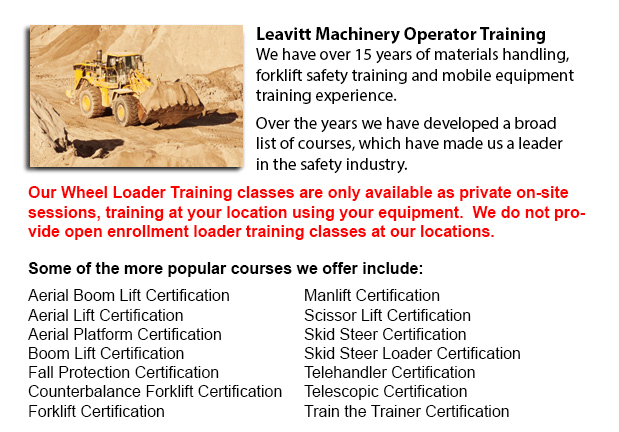
Kitchener Wheel Loader Operator Training - Cranes are industrial equipment that make use of pulleys or levers to pick up significant loads. The Roman people used cranes so as to put up large monuments, that means these machinery have been present for at least two thousand years. Several Medieval churches used cranes in their creation as well as the Egyptians might have relied on them when building the pyramids.
New cranes could either be complex or simple, based on the nature of the function they can do. For example, mobile cranes are rather simple units. A steel truss and even a telescopic boom mounts its movable platform. A system of levers or pulleys lifts the boom and there is usually a hook hanging. These cranes are frequently utilized for earthmoving or demolition by changing the hook out with one more piece of device such as a wrecking ball or a bucket. Telescopic cranes have a series of hydraulic tubes that fit together to form the boom. These units could even be mobile.
Both specialized or traditional wheels can be utilized for caterpillar track or railroad track enabling these boom trucks to move on upaved and uneven surfaces.
Rough terrain and truck mounted cranes are mobile too. Outriggers are placed on the truck mounted model in order to improve stability, while rough terrain cranes consist of a base that tends to resemble the bottom of a 4-wheel drive. These cranes are outfitted in order to function on rough ground making them ideal in the construction industry for instance.
Usually utilized on ports and in railroads, the Gantry crane can transfer and unload huge containers off ships and trains. Their bases have massive crossbeams that run on rails so as to raise containers from a place to another. A portainer is a special type of gantry which transports supplies onto and off of ships in particular.
Floating cranes are mounted on barges or pontoons and are one more important piece of machinery essential to the shipping industry. As they are situated in water, they are used for a variety of services consisting of building bridges, salvaging ships and port construction. Floating cranes could handle really heavy cargo and containers and like portainers, they can also unload ships.
Loader cranes comprise hydraulic driven booms that are fitted onto trailers to load merchandise onto a trailer. The jointed parts of the boom could be folded down when the machine is not in being used. This particular kind of crane could be even considered telescopic since a section of the boom could telescope for more versatility.
Normally seen in automated warehouses, stacker cranes tend to follow an automatic retrieval system and could work using a remote. These cranes are equipped along with a lift truck equipment and can be found in huge automated freezers, stacking or obtaining foodstuff. Using this kind of system enables employees to remain out of that freezing situation.
Tower cranes are frequently the tallest cranes and typically do not have a movable base. They must be assembled part by part. Their base resembles a long ladder with the boom perpendicular to the base. These cranes specialize in the construction of tall buildings and are normally affixed to the inside of the building itself throughout the construction period.
-
Kitchener Forklift Training Schools
Kitchener Forklift Training Schools - The Advantages Of Taking One Of Our Forklift Training Schools Are you searching for work as a driver of a forklift? Our regulatory-compliant mobile equipment operator training offers instruction in types of fo... More -
Kitchener Overhead Crane Operator Training
Kitchener Overhead Crane Operator Training - Our overhead crane operator training course is designed to teach employees the basics of overhead crane/sling operation and pre-shift checks. Courses are taught by our expert trainers and consultants. Well... More -
Kitchener Crane Training School
Kitchener Crane Training School - The crane training school offers industry-relevant programs. Courses provide trainees with learning outcomes which match present industry demands. Our small class sizes combine hands-on experience and theory. Our qua... More -
Kitchener Skid Steer Ticket
Kitchener Skid Steer Ticket - The lift arms on the skid-steer loader are located at the side of the driver along with pivots behind the driver's shoulders. These features makes the skid-steer loader different as opposed to the conventional front load... More -
Kitchener Manlift Operator Certification
Kitchener Manlift Operator Certification - Our scissor platform and aerial lift training and certification empowers participants with a knowledge and general understanding of the efficient and safe use of "Power Operated Mobile Work Platforms," under... More -
Kitchener Crane Safety Training
Kitchener Crane Safety Training - Companies and crane operators have to be aware of the problems related to crane safety. Legislation provides rules for the safe operation, inspection and maintenance of lifting machines all around North America. Cran... More -
Kitchener Forklift Training Programs
Kitchener Forklift Training Programs - Are you searching for work as a forklift driver? Our regulatory-compliant mobile equipment operator training offers instruction in kinds of forklifts, pre-shift check, fuel kinds and dealing with fuels, and safe... More -
Telehandler Training in Kitchener
Telescopic handlers often known as telehandlers for short, are an extremely popular piece of heavy construction machinery. They are commonly used in the construction and agricultural industries. These equipments have extreme reaching ability and can... More

Forklift Certification Kitchener
TOLL FREE: 1-888-254-6157
Kitchener, Ontario
forkliftcertificationkitchener.com
Email Us
About Us


